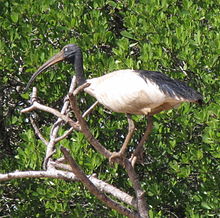Malagasy sacred ibis
| Malagasy sacred ibis | |
|---|---|
 |
|
| Scientific classification | |
| Kingdom: | Animalia |
| Phylum: | Chordata |
| Class: | Aves |
| Order: | Pelecaniformes |
| Family: | Threskiornithidae |
| Genus: | Threskiornis |
| Species: | T. bernieri |
| Binomial name | |
|
Threskiornis bernieri (Bonaparte, 1855) |
|
The Malagasy sacred ibis (Threskiornis bernieri) is a relatively large, heavily built ibis endemic to the west coast of Madagascar, and Aldabra on the Seychelles.
The Malagasy sacred ibis was formerly considered a subspecies of the African sacred ibis. It is now however classified as a separate species from the African sacred ibis due to considerable differences observed in the former’s ecology and morphology. It is hypothesized that the Malagasy sacred ibis evolved from the African sacred ibis when the latter supposedly spread to and colonized Madagascar from mainland Africa.
There are two different races of the Malagasy sacred ibis: Threskiornis bernieri bernieri (Bonaparte, 1855) on Madagascar, and T.b. abbotti (Ridgway, 1893) on Aldabra in the Seychelles.
The adult stands 65–89 cm tall, with a wingspan of 112–124 cm. The plumage is predominantly white, often with brownish-yellow staining. There are also black ornamental plumes on the back with a blue or green gloss formed from the lower scapulars and tertials, which are most prominent in the breeding season. The bill, head, neck and legs are black.
This ibis is morphologically similar to the African sacred ibis, but is slightly smaller, more slender-billed, lacks the black trailing edge to the wings, has bluish-slate tertials (purplish-slate in the African sacred ibis), differently structured ornamental neck sacs, less developed ornamental plumes and a different display. Unlike the African sacred ibis, there is also little or no black on the wing tips and duller display plumes from the innermost secondaries.
Both the bernieri and abbotti race have a light blue or white iris, both of which differ markedly from the brown iris of the African sacred ibis. The abbotti race also has a black wing stripe. Although this ibis is unlikely to be confused with other species in the field, it may sometimes be mistaken for the African sacred ibis which may occasionally visit Madagascar as a vagrant.
The juvenile appears similar to the adult, but the head and neck are feathered black with white streaks, the ornamental plumes on the back are absent, and there may be some black on the wing tips.
It is generally non-vocal, but the voice is probably similar to that of the African Sacred Ibis.
Apart from its occurrence on Aldabra, the Malagasy sacred ibis is sparsely distributed along and restricted to the west coast of Madagascar, especially between Port-Berge and Moromoe. Although uncommon, some high densities of resident breeding populations have been observed in mangroves and estuaries near Soalala and Sahamalaza Bay and Baie de Baly; the region encompassed between these locations appears to be a species’ stronghold.
The Malagasy sacred ibis is generally restricted to coastal mudflats, estuaries, mangrove swamps and shallow brackish coastal lakes; but is occasionally found on freshwater wetlands. It preferentially frequents wide, open pools without surrounding vegetation; as well as sand bars and sandy beaches for general resting places. In one survey, over 80% of individuals recorded were found within 2 km of the coastline. Its habitat is situated 0-150m above sea level. This species is considered more ecologically restricted than its mainland African counterpart, which is found in a wider range of habitats at a wider range of altitudes.
...
Wikipedia

